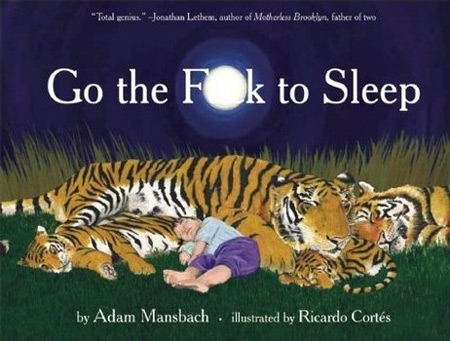Last week my husband asked me if I had heard an NPR segment about a soon-to-be released book called “Go the F**k to Sleep”. My jaw dropped. What did you say??? There’s a children’s book called that? It turns out it’s not as much a children’s book (phew!) as one for adults of young children who need humor and support when they’re just about to lose their minds.
My own kids seem to alternate the phases of who will be the one fighting bedtime with tooth and nails. Apparently they don’t want me to completely lose my sanity, so they trade roles every few weeks. You know the bedtime-dragging routine: I want one more book, one more drink, one more rub, one more hug, one more kiss, one more pee. One more kiss, again… It’s flattering to think they want to spend that much time with us every day, but that’s really not their intention.
All parenting books will tell you the same: kids like to test their boundaries and make sure they’re still where you set them the first time. Night after night some kids will test you just to see if you’ve shifted your stand. Ugh, honey, still not. Most nights, this conversation may take place at my house when one of my kids gets out of bed:
“I want one more hug.”
“It’s bedtime, go to sleep, please.”
5 minutes later:
“I don’t want to go to sleep.”
“Go to bed.”
5 more minutes later:
“Are we going to school tomorrow? I don’t want to go to school”.
“Go. To. Bed. Now.”
5 more minutes…
“I lost my <insert favorite cuddly toy>”.
“Argh, enough already!!!”
After three interruptions, I usually threaten my kids to sit in time out in the dark. I’m not sure why they don’t like it, because it’s not any different from laying down in their bed in the dark, but it usually does the trick. Still, the nightly testing is emotionally draining. I don’t want to be mean and rude, but what’s the point of running around the playground and burning calories the whole day if you’re not even tired at night?
Somehow young kids think their parents save all exciting activities for after bedtime. Do they imagine us partying with music and cake, playing with their toys and watching hours of movies? Funny, because most evenings at our house involve putting the dishes away, folding laundry, preparing the next day’s breakfasts and lunches, and keeping up with Facebook and blog updates. I’d trade most of those for sleep myself…
I know this is just a phase and it too will pass. I’m just glad another parent got the nerve to write about this frustrating side of parenthood. Pirate copies of Adam Mansbach’s “Go the F**k to Sleep” have apparently leaked over the internet (YouTube is a good place to look, if you’re curious) and parents are having a hoot reading it. Mansbach warns parents not to read the book to their kids even if they’re frustrated. No kidding. A much better idea would be to save kids a copy for when they’ll become parents themselves. They’ll need all the laughing relief they can get, while we grandparents enjoy a peaceful night at our own home!
If you’ve found a miracle to solving bedtime struggles, please share it here! I could use it.
If you enjoyed reading this post and would like to receive future postings, please enter your email address and click the Sign Up button at the top right of this page. Thank you for reading!
![]()
![]()
![]()
![]()
![]()
![]()
![]()
![]()


































